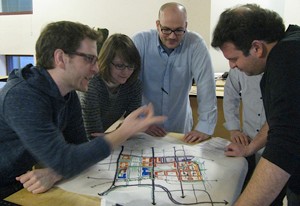
Design and Business Graduate Students Enter Prestigious Urban Design Contest
University of Cincinnati students hope they hit the right note with their entry into the 12th annual Urban Land Institute Gerald D. Hines Urban Design Competition. This years challenge was to re-envision a neighborhood in downtown Nashville, a municipality also known as Music City.
Students who led in UCs entry to the contest were
- Gretchen Keillor, graduate student in community planning, led the project.
- Luke Sinopoli, graduate student in architecture, served as the projects design leader.
- Aaron Guttman, graduate student in the real estate certificate program
- Ken Ko, graduate student in architecture
- Drew Suszko, graduate student in architecture and an MBA student
In the effort, the UC team was supported by Carla Chifos, associate professor of planning in the UC College of Design, Architecture, Art, and Planning (DAAP), with help from architect, master planner and urban designer John Ritter, a UC alumnus who earned both a masters of architecture and a masters in business administration here. Ritter is currently with local design and project management firm Chameleon Architecture. Also assisting with the project was Shaun Bond, professor of finance and director of UCs Real Estate Center in the Carl H. Lindner College of Business.
In a recent two-week period, this UC team examined and made detailed design, planning and economic suggestions for a Nashville neighborhood known as Sulphur Dell, a formerly industrial area adjacent to the very center of Nashvilles downtown where its historical Capitol building is located. The area has a lot of potential because of its location near the state Capitol complex, its well-known farmers market, proximity to the riverfront and, importantly, a new minor league ballpark going up.
Because that stadium will be a focal point but used for baseball games for only 80 days a year, the UC students suggested integrating other neighborhood events and amenities with and into the stadium. For instance, the stadium could serve as home base for music festivals; provide space for other, community-oriented sports; host movie nights in the infield and even Fourth of July celebrations.
The UC team also made suggestions for creating a walkable neighborhood (including a pedestrian mall connecting the neighborhood and the river) with LEED (leadership in energy & environmental design) certified building renovations/construction with both affordable and market-rate housing as well as office and commercial enterprises (like a flagship grocery) in mid-rise buildings.

Gretchen Keillor
According to Gretchen Keillor, 27, a masters of community planning student from Kent, Ohio, the students suggested that the overall resiliency and vibrancy of the neighborhood would be increased if each block had everything you need within a 15-minute walk, things like retail, restaurants and a convenience store. Each block must succeed on its own even while integrating with the focal point of the new minor-league stadium.
That block-by-block recipe for success would insulate the neighborhood should the baseball stadium eventually move or even fail to prosper in terms of drawing spectators.
UCs participation in the competition was the brainchild of Keillor. She explained, I asked other students to participate because it offered a great opportunity to meet a challenge. Here we have a site that we could seek to make work on the local level for the residents and, in turn, make it work for the city as a whole because of its proximity to the state Capitol complex.
Drew Suszko, 30, a masters of architecture student and a masters of business administration student from the Cincinnati neighborhood of Montgomery, explained that he wanted to participate in the contest because it offered a realistic, pragmatic challenge.
He explained, People increasingly live in cities, and the move to urban areas will likely continue as a broad trend. So, in these urban areas, residents need access to healthy options in terms of food and exercise like walking. These neighborhoods need to function on an everyday basis, and we were able to suggest means for doing that in our entry.
.
UCs Chifos agreed, stating, For our advanced students, the contest provides an opportunity to test their skills against their peers nationally. In addition, this is the kind of work theyll do and the kinds of decisions theyll have to make in the profession. So, it was both a learning opportunity and a showcase for our students.
Four finalist entries will be selected in the Urban Land Institute Gerald D. Hines Urban Design Competition, which is open to teams of graduate students in the United States and Canada. Those finalist teams will travel to Sulphur Dell and after visiting the site, will have the opportunity to revise and perfect their community design plans in the effort to win the $50,000 winning prize. Finalists should be announced this spring. There is no expectation that any of the entries will actually be applied to the site.
Related Stories
UC pioneers green innovation with award-winning sustainability...
April 22, 2024
In the heart of April, as Earth Day blooms, the University of Cincinnati's Sustainability and Utilities Departments took center stage, orchestrating a symphony of eco-conscious activities to boost campus consciousness towards greener living. From vibrant campus Spring Fling festivities to enlightening tours of UC's acclaimed Utilities Plant and Civic Garden, the university community was treated to a variety of events aimed at fostering sustainable behaviors.
UC's record graduating class prepares for next chapter
April 22, 2024
UC will confer degrees to 7,521 degrees to 7,391 students. (Some students are earning multiple degrees.) Both represent new records at UC for a single graduating class dating back two centuries.
Media coverage and word of mouth extends DAAP art exhibit to...
April 19, 2024
Due to popular draw, the art exhibit "Rediscovering Catharina van Hemessen’s Scourging of Christ: Women Artists, Patrons, and Rulers in Renaissance Europe" has been extended at the DAAP Library through April 30.
